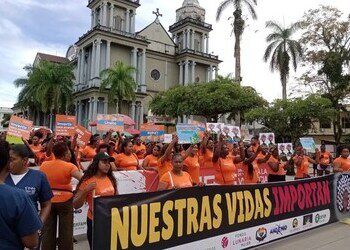In Quibdó, Colombia, local criminal gangs have put women in their crosshairs because of their links to rival groups, resorting to gender-based violence as a strategy for territorial control.
In early September, the Gaitanista Self-Defense Forces of Colombia (Autodefensas Gaitanistas de Colombia – AGC) disseminated a list with the names and photographs of at least 27 women via WhatsApp chats. All of the women had some kind of relationship with members of other criminal groups operating in Quibdo, the capital of Colombia’s Pacific coast department of Chocó. The strategy was dubbed “Plan Feminicidio” by the group.
“You have 24 hours to leave the city because you are now on a hit list,” the message said.
SEE ALSO:The Informants of Tibú: How the Colombian State Unleashed a Wave of Femicides
August in Quibdó was marked by a rise in femicides. A minor was murdered early in the month, and a few weeks later, hitmen killed Luz Berilia Chalá, a social leader and member of the Network of Mothers and Caregivers of Murdered Youths in Quibdó (la Red de Madres y Cuidadoras de Jóvenes Asesinados en Quibdó).
Although the AGC denied sending the threats in a statement published on September 29, the increase in femicides and fear, prompted several women to leave the city. On September 5, the NGO Road to Peace for Women (Ruta Pacifica de las Mujeres) warned that they had received 35 different threats against women in Quibdó since September began.
The spike in femicides came as the AGC gains strength in Quibdó, according to an alert from the Ombudsman’s Office. The situation has deteriorated since the rupture of a truce between local gangs – the Mexicanos, allegedly linked to the National Liberation Army (Ejército de Liberación Nacional – ELN), Lokos Yam, the Zetas, and RPS. The groups were seeking to negotiate with the Colombian government as part of the Total Peace policy, under which President Gustavo Petro’s administration has sought demobilization agreements with many of Colombia’s criminal groups.
“Everyone lives in this situation, but it is much more violent towards women,” Paola Marín, a researcher for the Territorial Peace and Human Rights line at the Peace and Reconciliation Foundation, told InSight Crime. “[Calling it Plan Feminicidio] shows how it is something systematic, that it is organized, that it is not a coincidence.”
InSight Crime Analysis
“Plan Feminicidio” shows, once again, how criminal groups use violence against women as a weapon of war in Latin America, especially when they are fighting over territory and control of criminal profits.
Throughout Colombia’s history of armed conflict and criminality, these strategies have been a way to hurt the enemy and humiliate communities.
The Colombian Observatory of Femicides (el Observatorio Colombiano de Feminicidios) emphasizes that although the dynamics are not new, they are worrying. “We have seen peaks [in femicides], above all in the context of the different territorial disputes between armed men exercising different forms of violence against women to win territorial power … We see how this violence is increasing in certain places like Cauca, Santander, Norte de Santander, Antioquia,” an analyst from the Observatory told InSight Crime.
SEE ALSO:How Colombia’s Conflict Intensified Violence Against Women and the LGBTQI+ Community
A variety of groups fighting for control of Quibdó have resorted to gender-based violence. “The threats were initially framed to blame the Clan del Golfo (as the AGC is known), but the truth is that all the criminal organizations and gangs there use the same strategies,” Marín added.
The practices continue in other parts of the country. In 2022, guerrilla groups in Tibú, Norte de Santander, used similar threats to displace, kill, and disappear dozens of women for their alleged links to security forces in the area. Departments such as Antioquia, Valle del Cauca, and Cauca also show alarming femicide figures for 2024, according to data from the Colombian Femicide Observatory.
Murdering women also succeeds in breaking community ties and generating fear, the observatory analyst told InSight Crime. Organized crime groups seek to target women who act as pillars of the social fabric — as mothers, caregivers, or leaders — to instill fear and crush community initiatives to entrench their social control. Other countries in the region have experienced similar waves of violence against women.
In Haiti, during disputes between the G9 and Familia and G-PEP gang confederations, both sides were accused of interrogating and sexually abusing women with alleged family or emotional ties to their rivals with impunity. In Venezuela, criminal gangs murder women linked to rival gangs or security forces to affect their rivals or send a message of power, according to figures collected by civil society organizations. In addition, they have murdered women who exercise leadership within their communities to inspire fear and entrench their social control.
Feature image: A peaceful march in the city of Quibdó to mark the international day for the elimination of violence against women. Credit: SweFOR Colombia
Source link : http://www.bing.com/news/apiclick.aspx?ref=FexRss&aid=&tid=6706bcace10d49cdba2677c5ee036267&url=https%3A%2F%2Finsightcrime.org%2Fnews%2Fviolence-against-women-is-being-used-as-a-weapon-of-war-in-colombia-again%2F&c=470490935493556047&mkt=en-us
Author :
Publish date : 2024-10-09 05:18:00
Copyright for syndicated content belongs to the linked Source.
